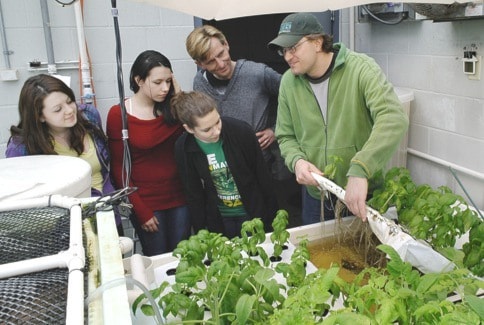Wellington Secondary School students are thinking outside the garden box when it comes to growing plants.
Students in John Mandziuk's leadership class want to set up a green wall aquaponics system – a wall of plants connected to a tank of fish.
The research and planning is complete, but the students need funding to buy the equipment. The group has entered the B.C. Green Games, Science World's annual environmental action contest for B.C. schools, which gives the school a chance of winning a $1,000 grant as chosen by a panel of judges and/or a $500 grant for garnering the most votes online.
Voting ends today (March 31) at http://www.bcgreengames.ca.
The goal is to have the project up and running by the end of the school year.
Grade 12 student Kieryn Matthews, founder and president of the Wellington Environmental Club as well as project leader on the aquaponics project, said she took over the idea of establishing a green wall from another student, who started researching it last year.
The project has morphed from a large wall at the front of the school to a smaller wall in the inner courtyard with an aquaponics system attached.
Matthews liked the idea of adding the fish tank because the system uses less energy and water than growing plants the traditional way, acts as a natural insulator for the wall to reduce heating and cooling costs, and is a solution to space challenges, as the world is running out of horizontal spaces to grow enough food to sustain everyone.
"I like the idea of doing this at a high school where we can learn about sustainability," she said. "There's been lots of community gardens, but this is definitely a step above."
Students need about $2,000 for the first phase of the system, which includes a 600-gallon tank, a pump, the wall panel and the fish – they plan to start off with tilapia, but hope to obtain a licence down the road to grow trout.
The plants – local sedums gathered from the gardens of students and teachers – are under grow lamps at the back of a science class, said Matthews.
"We know the pieces we need, we just need the money to get it," she said.
To that end, Matthews has been furiously writing grant applications and plans to make presentations to community groups – a presentation to the Departure Bay Neighbourhood Association garnered $100 for her cause.
Once the system is established, Mandziuk hopes to add more panels over time and grow food-bearing plants, such as strawberries.
He said aquaponics is an efficient way to grow plants and care for fish at the same time.
A bacteria converts the fish waste to fertilizer before pumping it to the top of the green wall and as the water filters down the wall, the plants clean the water before it goes back in the fish tank.
Mandziuk said the whole process uses 90 per cent less water than normal agricultural methods, doesn't deplete soil because no soil is used and because the water is constantly flowing, plants are never without it.
"Fish fertilizer is one of the best fertilizers out there," he said.
The project gives students a reason to learn, added Mandziuk, because they are able to apply all of the research they've done.
